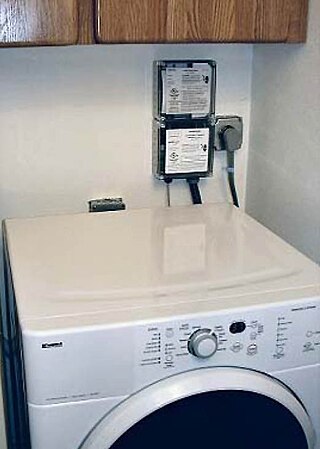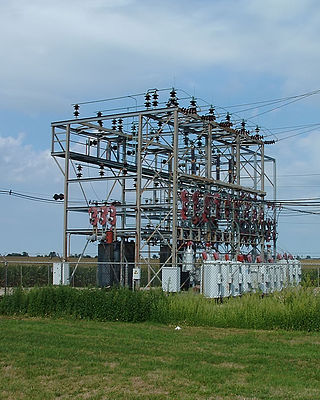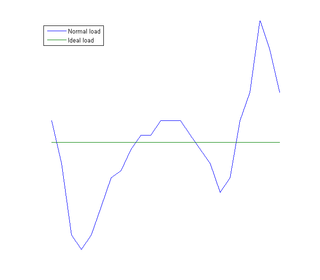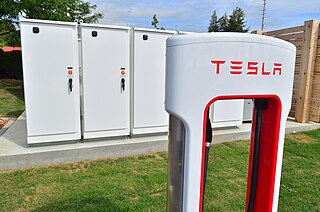Related Research Articles
Distributed generation, also distributed energy, on-site generation (OSG), or district/decentralized energy, is electrical generation and storage performed by a variety of small, grid-connected or distribution system-connected devices referred to as distributed energy resources (DER).

Net metering is an electricity billing mechanism that allows consumers who generate some or all of their own electricity to use that electricity anytime, instead of when it is generated. This is particularly important with renewable energy sources like wind and solar, which are non-dispatchable. Monthly net metering allows consumers to use solar power generated during the day at night, or wind from a windy day later in the month. Annual net metering rolls over a net kilowatt-hour (kWh) credit to the following month, allowing solar power that was generated in July to be used in December, or wind power from March in August.
Energy demand management, also known as demand-side management (DSM) or demand-side response (DSR), is the modification of consumer demand for energy through various methods such as financial incentives and behavioral change through education.

Grid energy storage is a collection of methods used for energy storage on a large scale within an electrical power grid. Electrical energy is stored during times when electricity is plentiful and inexpensive or when demand is low, and later returned to the grid when demand is high, and electricity prices tend to be higher.

Vehicle-to-grid (V2G), also known as Vehicle-to-home (V2H), describes a system in which plug-in electric vehicles (PEV) sell demand response services to the grid. Demand services are either delivering electricity or reducing their charging rate. Demand services reduce pressure on the grid, which might otherwise experience disruption from load variations. Vehicle-to-load (V2L) and Vehicle-to-vehicle (V2V) are related, but the AC phase is not sychronised with the grid, so the power is only available to an "off grid" load.

Demand response is a change in the power consumption of an electric utility customer to better match the demand for power with the supply. Until the 21st century decrease in the cost of pumped storage and batteries, electric energy could not be easily stored, so utilities have traditionally matched demand and supply by throttling the production rate of their power plants, taking generating units on or off line, or importing power from other utilities. There are limits to what can be achieved on the supply side, because some generating units can take a long time to come up to full power, some units may be very expensive to operate, and demand can at times be greater than the capacity of all the available power plants put together. Demand response, a type of energy demand management, seeks to adjust in real-time the demand for power instead of adjusting the supply.

Microgeneration is the small-scale production of heat or electric power from a "low carbon source," as an alternative or supplement to traditional centralized grid-connected power.
A virtual power plant (VPP) is a cloud-based distributed power plant that aggregates the capacities of heterogeneous distributed energy resources (DER) for the purposes of enhancing power generation, trading or selling power on the electricity market, and demand side options for load reduction.

Hybrid power are combinations between different technologies to produce power.

Dispatchable generation refers to sources of electricity that can be programmed on demand at the request of power grid operators, according to market needs. Dispatchable generators may adjust their power output according to an order. Non-dispatchable renewable energy sources such as wind power and solar photovoltaic (PV) power cannot be controlled by operators. Other types of renewable energy that are dispatchable without separate energy storage are hydroelectric, biomass, geothermal and ocean thermal energy conversion.

Load balancing, load matching, or daily peak demand reserve refers to the use of various techniques by electrical power stations to store excess electrical power during low demand periods for release as demand rises. The aim is for the power supply system to have a load factor of 1.

Load management, also known as demand-side management (DSM), is the process of balancing the supply of electricity on the network with the electrical load by adjusting or controlling the load rather than the power station output. This can be achieved by direct intervention of the utility in real time, by the use of frequency sensitive relays triggering the circuit breakers, by time clocks, or by using special tariffs to influence consumer behavior. Load management allows utilities to reduce demand for electricity during peak usage times, which can, in turn, reduce costs by eliminating the need for peaking power plants. In addition, some peaking power plants can take more than an hour to bring on-line which makes load management even more critical should a plant go off-line unexpectedly for example. Load management can also help reduce harmful emissions, since peaking plants or backup generators are often dirtier and less efficient than base load power plants. New load-management technologies are constantly under development — both by private industry and public entities.

Solar power, also known as solar electricity, is the conversion of energy from sunlight into electricity, either directly using photovoltaics (PV) or indirectly using concentrated solar power. Photovoltaic cells convert light into an electric current using the photovoltaic effect. Concentrated solar power systems use lenses or mirrors and solar tracking systems to focus a large area of sunlight to a hot spot, often to drive a steam turbine.
Through the 1996 Electric Utilities Act the Alberta's deregulated electricity market began.

Solar power has been growing rapidly in the U.S. state of California because of high insolation, community support, declining solar costs, and a renewable portfolio standard which requires that 60% of California's electricity come from renewable resources by 2030, with 100% by 2045. Much of this is expected to come from solar power via photovoltaic facilities or concentrated solar power facilities.

The Alberta Electric System Operator (AESO) is the non-profit organization responsible for operating Alberta, Canada's power grid. AESO oversees the planning and operation of the Alberta Interconnected Electric System (AIES) in a "safe, reliable, and economical" manner. It is mandated by provincial legislation to act in the public interest and cannot own any transmission, distribution or generation assets.

The energy sector in Hawaii has rapidly adopted solar power due to the high costs of electricity, and good solar resources, and has one of the highest per capita rates of solar power in the United States. Hawaii's imported energy costs, mostly for imported petroleum and coal, are three to four times higher than the mainland, so Hawaii has motivation to become one of the highest users of solar energy. Hawaii was the first state in the United States to reach grid parity for photovoltaics. Its tropical location provides abundant ambient energy.

Variable renewable energy (VRE) or intermittent renewable energy sources (IRES) are renewable energy sources that are not dispatchable due to their fluctuating nature, such as wind power and solar power, as opposed to controllable renewable energy sources, such as dammed hydroelectricity or biomass, or relatively constant sources, such as geothermal power.

The Australian electricity sector has been historically dominated by coal-fired power stations, but renewables are forming a rapidly growing fraction of supply.

The Tesla Powerpack was a rechargeable lithium-ion battery stationary energy storage product, intended for use by businesses or on smaller projects from power utilities. The device was manufactured by Tesla Energy, the clean energy subsidiary of Tesla, Inc. The Powerpack stores electricity for time of use load shifting, backup power, demand response, microgrids, renewable energy integration, frequency regulation, and voltage control. The first prototype Powerpacks were installed in 2012 at the locations of a few industrial customers. After July 22, 2022, the product was no longer listed for sale.
References
- ↑ iEnergy: Reinventing Energy Systems for the Future | Scott Foster | TEDxPlaceDesNations , retrieved 2022-03-21
- ↑ Darke, Walker (2021). "Sustainable energy security in Kazakhstan: exploring the policies of China and the United Nations Economic Commissions". Peking University Thesis Library: 54.
- ↑ "Constant Power Inc". Constant Power Inc. Archived from the original on 2019-01-26. Retrieved 2022-01-12.
- ↑ Wang, Ucilia. "4 Things You Should Know About Energy Storage". Forbes. Retrieved 2 January 2017.
- ↑ "Con Edison Battery REV Demo | GI Energy US". GI Energy US. Archived from the original on 2017-10-20. Retrieved 2017-10-19.
- ↑ "Energy Storage-as-a-Service". Greentech Media. Retrieved 2 January 2017.
- ↑ "Energy Storage as a Service". Troes Corp. Retrieved 2021-11-11.
- ↑ Joe. "Stem: Energy Strorage-as-a-Service, Delivering Value to Customers and Utilities". Harvard Technology and Operations Management. Retrieved 2 January 2017.
- ↑ "Younicos launches service to rent energy storage systems". Utility Dive. Retrieved 2018-08-30.
- ↑ "How Lithium-ion batteries work". electronics.howstuffworks.com. How Stuff Works TECH. 14 November 2006. Retrieved 28 June 2016.
- ↑ "Flow Batteries". energystorage.org. Energy Storage Association. Retrieved 24 May 2016.
- ↑ "Compressed Air Energy Storage (CAES)". energystorage.org. Energy Storage Association. Retrieved 13 February 2016.
- ↑ "Flywheels". www.explainthatstuff.com. Explain That Stuff!. 11 January 2012. Retrieved 1 March 2016.
- ↑ "Hydro Technology – Pumped Storage". www.hydro.org. National Hydropower Association. Archived from the original on 17 March 2016. Retrieved 8 March 2016.
- ↑ "Energy Storage Technologies". energystorage.org. Energy Storage Association. Retrieved 30 March 2016.
- ↑ "What is SCADA?". inductiveautomation.com. Inductive Automation. Retrieved 27 December 2015.
- ↑ "Energy Management Systems". ems3.com/. EMS3. Retrieved 16 October 2015.
- ↑ "Power Conversion System for Energy Storage" (PDF). www.parker.com. Parker. Retrieved 29 September 2016.[ permanent dead link ]
- ↑ "Battery Management System (BMS)". www.mpoweruk.com. Electropaedia. Retrieved 11 December 2015.
- ↑ "Coincident Peak and Your Electricity Costs". www.energymanagertoday.com. Energy Manager Today. Retrieved 12 February 2016.
- ↑ "Demand Response". energy.gov. Energy.Gov. Retrieved 9 July 2015.
- ↑ "Practical Power Factor Correction". www.allaboutcircuits.com. All About Circuits. Retrieved 2 June 2016.
- ↑ "Power Quality". adfpowertuning.com. Power Tuning. Retrieved 4 October 2016.
- ↑ "Backup Power Generator, Emergency Power Supply". www.duracellpower.com. Duracell. Retrieved 19 September 2016.
- ↑ "Peak Shaving". new.abb.com. ABB. Archived from the original on 21 March 2016. Retrieved 29 March 2016.
- ↑ "Energy Storage on the Grid Edge". www.greentechmedia.com. Greentech Media. Retrieved 18 January 2016.
- ↑ "Ancillary Services – AESO". www.aeso.ca. AESO. Retrieved 28 September 2016.
- ↑ "Transmission and Distribution Deferral". redflow.com. Red Flow. Archived from the original on 22 July 2016. Retrieved 13 August 2016.
- ↑ "Survey of Commercial and Institutional Energy Use – Buildings 2009" (PDF). oee.nrcan.gc.ca. Archived from the original (PDF) on 2017-01-11. Retrieved 2016-10-24.
- ↑ "Energy Incentive Programs". energy.gov. Office of Energy Efficiency and Renewable Energy. Retrieved 23 January 2016.
- ↑ "Energy Service Agreements". www.energ-group.com. ENER-G. Retrieved 30 September 2015.
- ↑ "Renewable Energy Project Financing: Impact of the Financial Crisis and Federal Legislation" (PDF). www.nrel.gov. National Renewable Energy Laboratory. Retrieved 17 July 2016.
- ↑ "Energy Storage Opportunities and Challeneges" (PDF). www.ecofys.com. ECOFYS. Retrieved 19 January 2016.
- ↑ "Network Operations Center (NOC)". www.techopedia.com. Techopedia. 19 June 2015. Retrieved 31 January 2016.
- ↑ "What is a Service Contract". www.businessdictionary.com. Business Dictionary. Archived from the original on 2 July 2016. Retrieved 30 June 2016.
- ↑ "Optimize Energy Use on a Large Scale" (PDF). www.cisco.com. Cisco. Retrieved 15 July 2016.
- ↑ "Energy Intelligence to Meet Your Biggest Challenges". www.enernoc.com. ENERNOC. Retrieved 17 November 2015.
- ↑ "Types of Renewable Energy". www.renewableenergyworld.com. Renewable Energy World. Archived from the original on 25 June 2016. Retrieved 18 May 2016.
- ↑ "Sources of Greenhouse Gas Emissions". www.epa.gov. US Environmental Protection Agency. 29 December 2015. Retrieved 30 April 2016.
- ↑ "What is the fixed price contract". www.businessdictionary.com. BusinessDictionary. Archived from the original on 30 June 2016. Retrieved 26 June 2016.